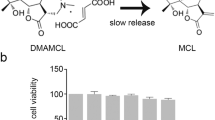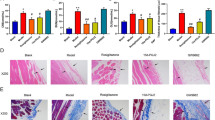Abstract
Background
Peritoneal dialysis has greatly improved patient survival for patients with chronic kidney disease. However, peritoneal fibrosis is a progressive fibrotic peritoneal disease caused by dialysis, which may lead to ineffective dialysis or dialysis failure. It is well known that the EMT of peritoneal mesenchymal cells has been known to contribute to peritoneal fibrosis. Therefore, at present, inhibiting the formation and development of EMT has become the focus of peritoneal fibrosis.
Objectives
Pirfenidone has shown clinically relevant benefits in patients with pulmonary fibrosis, however, there is no research on peritoneal fibrosis. Thus, we examined the effect of pirfenidone on AGE-driven EMT in peritoneal mesenchymal cells and assessed its efficacy in inhibiting peritoneal fibrosis.
Results
AGEs were added with or without pirfenidone to the culture medium of HMrSV5 cells and we detected the changes of EMT and the signaling pathways involved. AGEs greatly reduced the E-cadherin level and augmented the α–SMA and vimentin expression. However, these effects were dramatically suppressed by pirfenidone treatment. Meanwhile, the reactive oxygen species (ROS) induced by AGEs were suppressed by pirfenidone. Furthermore, under the action of AGEs, pirfenidone activated the nuclear transport of Nrf2, and accelerated the production of antioxidant factors.
Conclusion
Pirfenidone could attenuate AGE-mediated EMT in HPMCs and might be a promising therapeutic drug to antagonize peritoneal fibrosis.




Similar content being viewed by others
Abbreviations
- EMT:
-
Epithelial-to-mesenchymal transition
- AGEs:
-
Advanced glycation end products
- FBS:
-
Fetal bovine serum
- PVDF:
-
Polyvinylidene fluoride
- Nrf2:
-
Nucleus factor erythroid 2-related factor 2
- HPMCs:
-
Human peritoneal mesothelial cells
- DMSO:
-
Solubilization solution dimethyl sulfoxide
- ROS:
-
Reactive oxygen species
- PD:
-
Peritoneal fibrosis
- HO-1:
-
Oxygenase-1
References
Baird L et al (2011) The cytoprotective role of the Keap1-Nrf2 pathway. Arch Toxicol 85(4):241–272
Chan DD et al (2018) Pirfenidone reduces subchondral bone loss and fibrosis after murine knee cartilage injury. J Orthop Res 36(1):365–376
Cho ME et al (2010) Pirfenidone: an anti-fibrotic and cytoprotective agent as therapy for progressive kidney disease. Expert Opin Investig Drugs 19(2):275–283
Cho Y et al (2014) Peritoneal dialysis-related peritonitis: towards improving evidence, practices, and outcomes. Am J Kidney Dis 64(2):278–289
Choi P et al (2004) Peritoneal dialysis catheter removal for acute peritonitis: a retrospective analysis of factors associated with catheter removal and prolonged postoperative hospitalization. Am J Kidney Dis 43(1):103–111
Dewage SNV et al (2019) The efficacy of pirfenidone in a sheep model of pulmonary fibrosis. Exp Lung Res 45(9–10):310–322
Flores-Contreras L et al (2014) Treatment with pirfenidone for two years decreases fibrosis, cytokine levels and enhances CB2 gene expression in patients with chronic hepatitis C. BMC Gastroenterol 14:131
Khanum BNMK et al (2017) Pirfenidone inhibits post-traumatic proliferative vitreoretinopathy. Eye (Lond) 31(9):1317–1328
Kim YC et al (2019) ST2 blockade mitigates peritoneal fibrosis induced by TGF-β and high glucose. J Cell Mol Med 23(10):6872–6884
Kim JS et al (2020) Activation of the Nrf2/HO-1 pathway by curcumin inhibits oxidative stress in human nasal fibroblasts exposed to urban particulate matter. BMC Complement Med Ther 20(1):101
Kolset SO et al (2012) Diabetic nephropathy and extracellular matrix. J Histochem Cytochem 60(12):976–986
Li PK et al (2017a) Changes in the worldwide epidemiology of peritoneal dialysis. Nat Rev Nephrol 13(2):90–103
Li C et al (2017b) Pirfenidone controls the feedback loop of the AT1R/p38 MAPK/renin-angiotensin system axis by regulating liver X receptor-α in myocardial infarction-induced cardiac fibrosis. Sci Rep 16(7):40523
Lim SO et al (2008) Epigenetic changes induced by reactive oxygen species in hepatocellular carcinoma: methylation of the E-cadherin promoter. Gastroenterology 135(6):2128–2140
O’Shaughnessy MM et al (2019) Cause of kidney disease and cardiovascular events in a national cohort of US patients with end-stage renal disease on dialysis: a retrospective analysis. Eur Heart J 40(11):887–898
Pastushenko I et al (2019) EMT transition states during tumor progression and metastasis. Trends Cell Biol 29(3):212–226
Salah MM et al (2019) Pirfenidone alleviates concanavalin A-induced liver fibrosis in mice. Life Sci 15(239):116982
Shin DH et al (2010) The NRF2-heme oxygenase-1 system modulates cyclosporin A-induced epithelial-mesenchymal transition and renal fibrosis. Free Radic Biol Med 48(8):1051–1063
Sivandzade F et al (2019) Cerebrovascular and neurological disorders: protective role of NRF2. Int J Mol Sci 20(14):E3433
Smit W et al (2004) Analysis of the prevalence and causes of ultrafiltration failure during long-term peritoneal dialysis: a cross-sectional study. Perit Dial Int 24(6):562–570
Strippoli R et al (2016) Molecular mechanisms underlying peritoneal EMT and fibrosis. Stem Cells Int 2016:3543678
Sun YM et al (2013) Recent advances in understanding the biochemical and molecular mechanism of diabetic nephropathy. Biochem Biophys Res Commun 433:359–361
Wang Q et al (2018) RhoA/Rho-kinase triggers epithelial-mesenchymal transition in mesothelial cells and contributes to the pathogenesis of dialysis-related peritoneal fibrosis. Oncotarget 9(18):14397–14412
Wells AR et al (2020) Pirfenidone attenuates the profibrotic contractile phenotype of differentiated human dermal myofibroblasts. Biochem Biophys Res Commun 521(3):646–651
Wencheng Yu et al (2017) Effects and mechanisms of pirfenidone, prednisone and acetylcysteine on pulmonary fibrosis in rat idiopathic pulmonary fibrosis models. Pharm Biol 55(1):450–455
Yang Y-C et al (2018) Pkcδ activation is involved in ROS-mediated mitochondrial dysfunction and apoptosis in cardiomyocytes exposed to advanced glycation end products (Ages). Aging Dis 9(4):647–663
Acknowledgements
I need to thank Academician Chen Xiangmei, Associate professor of medicine Li Qinggang and Supervisor nurse Zhou lili for their thoughts and insights on the design of our research and their contributions to the successful completion of this research.
Author information
Authors and Affiliations
Contributions
XF and LM designed the study, wrote and revised the manuscript. XF, WS, ZZ and YH conducted the experiment. XF contributed the data collection and data analysis. XF and LM revised the manuscript. All our authors carefully read and clearly approved the final manuscript.
Corresponding author
Ethics declarations
Conflict of interest
Xiao Fenglin, Wang Shengyuan, Zhang Zhiyong, Yu Hai and Li Mingxu declare that there are not any commercial, financial or associative interest that represents a conflict of interest in connection with the manuscript entitled “Pirfenidone ameliorated AGEs induced EMT and attenuated peritoneal fibrosis in peritoneal mesothelial cells”.
Ethical approval
This article does not contain any studies with human participants or animals performed by any of the authors.
Rights and permissions
About this article
Cite this article
Fenglin, X., Shengyuan, W., Zhiyong, Z. et al. Pirfenidone ameliorated AGE-induced EMT and attenuated peritoneal fibrosis in peritoneal mesothelial cells. Mol. Cell. Toxicol. 17, 315–323 (2021). https://doi.org/10.1007/s13273-021-00138-5
Accepted:
Published:
Issue Date:
DOI: https://doi.org/10.1007/s13273-021-00138-5




